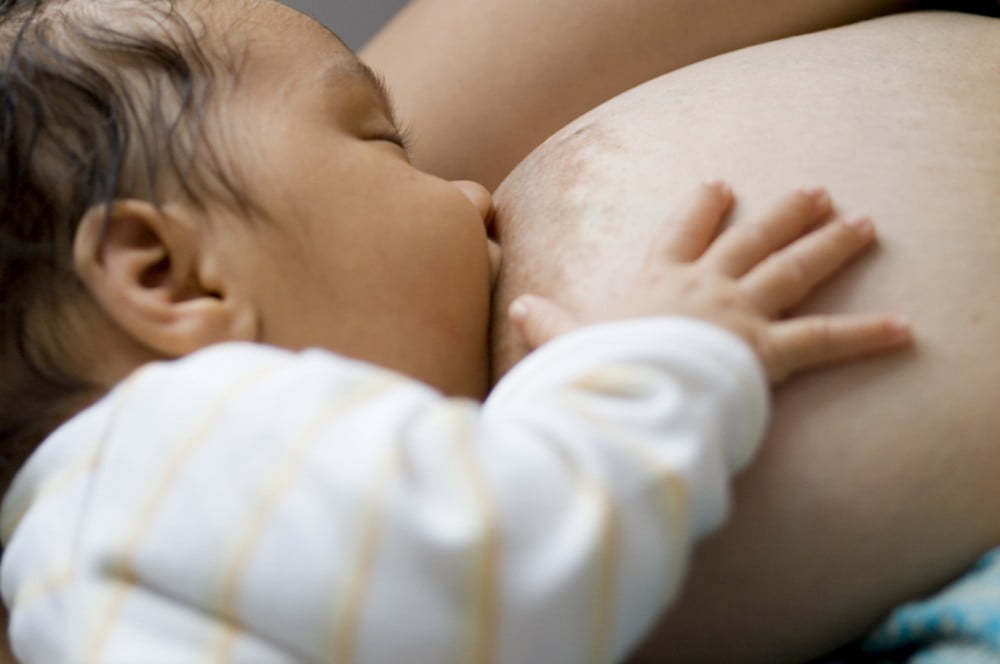Page last checked: 24 August 2022
“Increasing breastfeeding to near-universal levels for infants and young children could save over 800000 children’s lives a year worldwide, equivalent to 13% of all deaths in children under two, and prevent an extra 20000 deaths from breast cancer every year.”
This estimate is one of the headlines in today’s publication from The Lancet Breastfeeding Series Group of a major new analysis of worldwide breastfeeding levels, the benefits of breastfeeding and the implications for the economy, the environment and, of course, for health, of not doing so.
What is the evidence?

The Series draws on a large body of published and unpublished worldwide dataData is the information collected through research. from 28 systematic reviewsIn systematic reviews we search for and summarize studies that answer a specific research question (e.g. is paracetamol effective and safe for treating back pain?). The studies are identified, assessed, and summarized by using a systematic and predefined approach. They inform recommendations for healthcare and research. and meta-analyses, of which 22 were commissioned for the Series. Where possible, separate analyses were conducted for high-income countries (HICs) and low- and middle-income countries (LMICs) and the reviews include sub-analyses which control for confounding factors.
There are two Series papers. The first is concerned with breastfeeding trends and implications for health. For young children, they investigated mortalitydeath rates; growth; dental caries; and a number of disorders including respiratory infections and diarrhoea. For older children through to adults they looked at blood pressure; overweight and obesity; type 2 diabetes; total cholesterol; and intelligence. For mothers, lactational amenorrhoea; breast and ovarian cancer; type 2 diabetes; post-partum weight change; and osteoporosis.
The second looks at determinants of breastfeeding and the effectivenessThe ability of an intervention (for example a drug, surgery, or exercise) to produce a desired effect, such as reduce symptoms. of interventions to promote it. There is also an accompanying Commentary. Here are some key findings and messages, thinking especially about its importance for the UK.
Breastfeeding trends
Breastfeeding is one of the few positive health behaviours that is more prevalent in poor than rich countries. In HICs, better-educated women breastfeed more commonly than do those in low-income groups with fewer years of formal education.
Worldwide rates of breastfeeding are low and especially in HICs, in many of which just one in five infants is still breastfed at 12 months. The UK (<1%), Ireland (2%), and Denmark (3%) have some of the lowest rates of breastfeeding at 12 months. In the UK, a National Survey (covering 2005 to 2010) indicates a breastfeeding rateThe speed or frequency of occurrence of an event, usually expressed with respect to time. For instance, a mortality rate might be the number of deaths per year, per 100,000 people. of 81% for any breastfeeding, dropping to 34% at six months of age and 0.5% at a year.
Effects of breastfeeding on children

Short-term benefits of breastfeeding include reductions in infant deaths and infectious illnesses, persisting into the second year of life. There is a large protective effect for diarrhoea and respiratory infections. A meta-analysisThe use of statistical techniques in a systematic review to combine the results of included studies. Sometimes misused as a synonym for systematic reviews, where the review includes a meta-analysis. of six high quality studies in HICs showed that ever breastfeeding was associated with a 36% reduction in sudden infant deaths. Evidence mostly from HICs suggests a protective effect against otitis media in children under two but not for older children. There was no clear evidence of a protective effect for allergic disorders and only weak evidence of a reduction in asthma.
Long-term benefits (mostly from studies in HICs) may include a reduced riskA way of expressing the chance of an event taking place, expressed as the number of events divided by the total number of observations or people. It can be stated as ‘the chance of falling were one in four’ (1/4 = 25%). This measure is good no matter the incidence of events i.e. common or infrequent. of being overweight or obese and of developing diabetes (types 1 and 2). The evidence is not as strong as for infections but the associationA relationship between two characteristics, such that as one changes, the other changes in a predictable way. For example, statistics demonstrate that there is an association between smoking and lung cancer. In a positive association, one quantity increases as the other one increases (as with smoking and lung cancer). In a negative association, an increase in one quantity corresponds to a decrease in the other. Association does not necessarily mean that one thing causes the other. persists when restricted to high quality studies and to particular settings. There was no evidence of protective effects for blood pressure and cholesterol. Breastfeeding was consistently associated with higher performance in intelligence tests.
The only harmful consequence of breastfeeding detected here was an increase in tooth decay in children breastfed for more than 12 months.
Effects on the mother
Breastfeeding can improve birth spacing through longer periods of amenorrhoea. Breastfeeding is associated with lower rates of breast cancer, a 6% reduction for every 12 months of breastfeeding in a woman’s lifetime. It might also reduce the risk of ovarian cancer and diabetes.
Estimating lives saved
The authors estimate that the scaling up of breastfeeding from present levels to 12 months per child in HICs and two years per child in LMICs could prevent an estimated 823 000 child deaths and 20 000 breast cancer deaths every year.
What influences the uptake of breastfeeding?
I think there won’t be surprises for midwives in the list of factors determining breastfeeding, which were derived from a systematic review and from conceptual frameworks. Breastfeeding practices are, of course, affected by multiple factors, historical, cultural, socioeconomic and individual, and need supportive measures at many different levels, such as legislation, employment conditions and healthcare services.
Health systems and breastfeeding
Several healthcare-related barriers to breastfeeding were reported:
- Gaps in knowledge and skills to support breastfeeding at all levels of healthcare staff (reported in studies in Australia and Lithuania)
- Free samples of breastmilk substitutes
- Hospital practices such as mother-infant separation
- High risk pregnancies, assisted delivery and long hospital stays, maternal illness and preterm, low birthweight or ill newborns, can all result in breastfeeding starting later
Meta-analyses of interventions in health systems, communities and homes suggest that much can be done to improve breastfeeding practices. In healthcare settings, individual counselling or group education, immediate breastfeeding support at delivery, and lactation management were all found to be effective, increasing exclusive breastfeeding by 49% and any breastfeeding by 66%.
At the level of policy, the Series points to a failure to treat breastfeeding as “a key public health approach that can help prevent communicable and non-communicable disease, reduce infant mortality, and lessen inequity.” More commonly it is confined to more narrowly-defined agendas, such as nutrition.
The impact of the breastmilk substitute industry
According to Series author Professor Cesar Victora from the Federal University of Pelotas in Brazil,
“There is a widespread misconception that breastmilk can be replaced with artificial products without detrimental consequences. The evidence outlined in the Series, contributed by some of the leading experts in the field, leaves no doubt that the decision not to breastfeed has major long-term negative effects on the health, nutrition and development of children and on women’s health.”
The Series highlights the negative influence of breastmilk substitute (BMS) marketing, which can be aggressive and inappropriate. The International Code of Marketing of Breastmilk Substitutes and its subsequent resolutions (the Code), adopted at the 34th World Health Assembly in 1981, is intended to offer protection from inappropriate marketing strategies used by BMS companies, but it is inadequately implemented and monitored in the UK and elsewhere. Investigations by WHO and Save The Children find that, in contravention of the Code, some BMS companies seek to influence governments and health professionals in various ways, including through event sponsorship, incentives to promote their products and links with professional bodies. Some also promote their products directly to pregnant and breastfeeding women. Conflicts of interest and conflicting political priorities undermine efforts at all levels to support women to breastfeed.
It’s an industry that is growing, with global sales expected to reach US$70.6 billion by 2019. In HICs, growth is expected to be driven by sales of follow-on and toddlers milk, set to increase by 15% by 2019. Among HICs, only in France and the USA are sales expected to fall, as a result of legislation, public awareness campaigns and actions by civil society in support of breastfeeding. In the UK, the milk formula market is the 11th largest in the world and growing.
This Series underlines the importance of comprehensive national laws and regulations, properly enforced and monitored, to curb inappropriate marketing in order to protect and promote breastfeeding.
Environmental and economic impact
Not breastfeeding has environmental costs, as BMS leave an ecological footprint, needing energy for manufacture, packaging materials, fuel for transport and so on. Breastfeeding is important in terms of environmental sustainability and food security.
The Series includes economic modeling to indicate potential benefits of reduced treatmentSomething done with the aim of improving health or relieving suffering. For example, medicines, surgery, psychological and physical therapies, diet and exercise changes. costs and of improved cognition associated with improved breastfeeding practices. Their analyses suggest that the economic benefits are likely to be substantial. The authors also say that reliable estimates of the costs and benefits of the actions needed to support breastfeeding are difficult to calculate and that more work is urgently needed.
A call to action
Six action points are proposed:
- Disseminate the evidence
- Foster positive societal attitudes to breastfeeding
- Show political will
- Regulate the breastmilk-substitute industry by better enforcement of current legislation
- Scale up and monitor breastfeeding interventions and trends in breastfeeding practices
- Political institutions to remove structural and societal barriers to breastfeeding
All 194 member states of the World Health Assembly have agreed on breastfeeding targets for 2025. The Series Group finds that these targets are realistic and could be exceeded. An important message, underpinned by the evidence presented here, is that responsibility for successful breastfeeding lies not just with the woman but with society as a whole. Scaling up interventions, policies and practices to support breastfeeding has the potential to rapidly improve uptake. Political commitment and financial investment are needed to protect, promote, and support breastfeeding at all levels—family, community, workplace, and government, say the authors.
If anyone is tempted to think that this matters less for high-income countries, Professor Victora is clear that it matters for us all:
“There is a widespread misconception that the benefits of breastfeeding only relate to poor countries. Nothing could be further from the truth…Our work for this Series clearly shows that breastfeeding saves lives and money in all countries, rich and poor alike.”

New Lancet Breastfeeding Series is a call to action by Sarah Chapman is licensed under a Creative Commons Attribution-NoDerivatives 4.0 International License.
Based on a work at www.thelancet.com/series/breastfeeding. Images are purchased from istock.com for Evidently Cochrane and are not available for reproduction.
Links:
Victora CG, Bahl R, Barros AJD, Franca GVA, Horton S, Krasevec J, Murch S, Sankar MJ, Walker N, Rollins NC, for The Lancet Breastfeeding Series Group. Breastfeeding in the 21st Century: epidemiologyThe study of the health of populations and communities, rather than individuals., mechanisms and lifelong effect. (Breastfeeding Series 1). Lancet 2016; 387: 475-90. Available from: www.thelancet.com/series/breastfeeding
Rollins NC, Bhandari N, Hajeebhoy N, Horton S, Lutter CK, Martines JC, Piwoz EG, Richter LM, Victora CG, for The Lancet Breastfeeding Series Group. Why invest, and what it will take to improve breastfeeding practices? (Breastfeeding Series 2). Lancet2016; 387: 491-504. Available from: www.thelancet.com/series/breastfeeding
Comments:
McFadden A, Mason F, Baker J, Begin F, Dykes F, Grummer-Strawn L, Kenney-Muir N, Whitford H, Zehner E, Renfrew MJ. Spotlight on infant formula: coordinated global action needed. (Comment). Lancet 2016; 387: 413-5. Available from:www.thelancet.com/series/breastfeeding
Hansen K. Breastfeeding: a smart investment in people and economies. (Comment). Lancet 2016; 387: 416. Available from:www.thelancet.com/series/breastfeeding
Press Release:
The Lancet Press Office. The Lancet: Increasing breastfeeding worldwide could prevent over 800,000 child deaths and 20,000 deaths from breast cancer every year. [Press release]. 27 January 2016. Embargo: 23:30 [UK time] Thursday 28 January 2016. Available from: pressoffice@lancet.com



[…] deeply embedded in our society. UNICEF’s approach is underpinned by evidence set out in a two-part 2016 Lancet series which concluded that responsibility for successful breastfeeding lies with society as a whole […]
So the evidence is there. Why is it that of those who start breastfeeding in the UK the majority stop within the first few weeks? In my personal experience (in the UK, in my area at least) support for breastfeeding is only available to new mothers when it is proactively sought out. It’s only down to the determination of my wife in seeking support for herself that our 2 children were both breastfed for well over 1 year. Without the help that she had to seek out, a few days or weeks would have been all that was possible. Anything to change policy or societal attitudes is very welcome.
My experience was that the midwives actively discouraged me from breastfeeding past 3 months. When my daughter was 9 months old we moved house from Northern Ireland to England. Midwives in both countries were strongly hinting that they thought I was weird and that continuing to breast feed was inappropriate